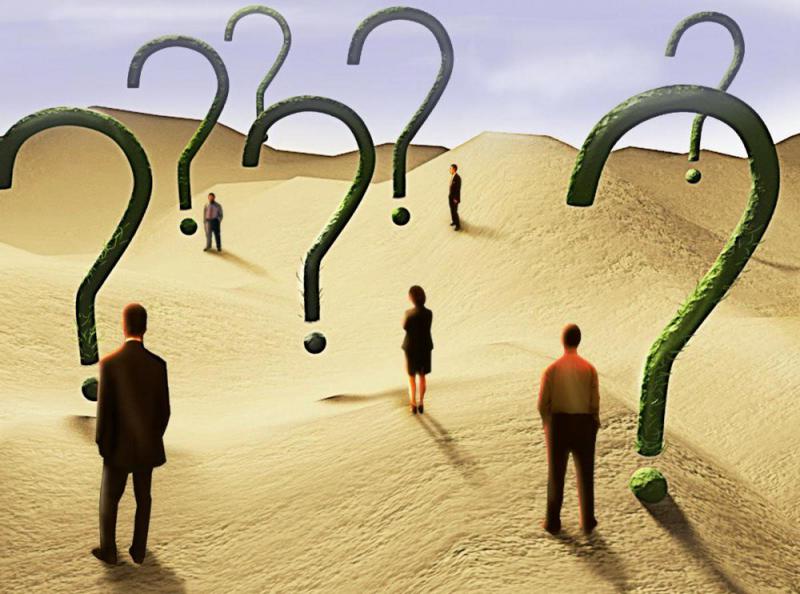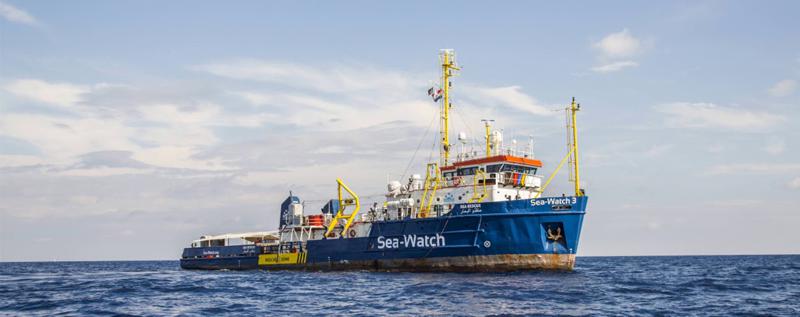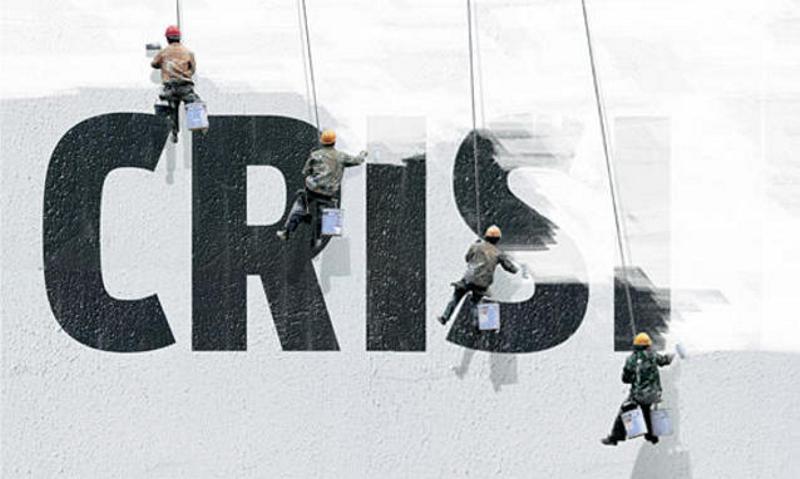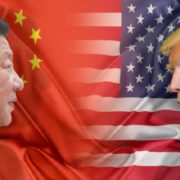On July 3, the present ruling coalition, made up of the Five Star Movement (M5s) and the League, didn’t secure any positions in the EU Commission or Parliament. The only post for Italy went to a member of the opposition: the Democratic Party’s (PD) David Sassoli was elected president of the European Parliament. That is, the EU de facto declared it doesn’t quite recognize the standing Italian government, and it would rather do business with the opposition.
The day after, on July 4, the Italian Prime Minister Giuseppe Conte, with his deputies Luigi Di Maio (M5s) and Matteo Salvini (League) were wining and dining with Vladimir Putin, who was visiting Rome to see the Pope. It is unclear whether Washington was supportive of the Italian government’s choice of celebration on the American national day.
Just a few days earlier, pro-Egypt (and in fact anti-Italian) general Khalifa Haftar started an offensive against Tripoli, held by a UN- and Italy-backed coalition. This was practically hours after Germany and France criticized Rome for the Seawatch 3 affair, which is bitterly dividing the Italian public opinion pro or against the arrival of immigrants. On June 26, the Dutch NGO ship Seawatch 3 docked without permission at the Italian port of Lampedusa carrying 42 migrants rescued off the Libyan coast.
On Friday June 21, at the G20 in Osaka, Dutch Prime Minister Mark Rutte declared that Italian debt would cause a eurozone meltdown. The statement could perhaps also be read as an indirect warning from Germany and France to Rome. The Dutch government is very close to Berlin and Paris and extremely dubious of Italian debt solvency.
Salvini in the past weeks was in Washington, where he received a kind of blessing from the U.S. government. But the American blessing does not mean that Italy can ignore the European Union, nor that Washington will protect Salvini against possible attacks from Brussels, especially if Salvini celebrates the U.S. national day with Putin. Moreover, Salvini received a credit to govern, but if he does not perform and continues to be on propaganda tours, as many of his critics claim, then what will happen?
In fact, economics perhaps is not really the issue. The Italian accounts are not so bad, as the president CONSOB (the independent body overseeing the Stock market), Paolo Savona, last month underlined, in the presence of Ignazio Visco, the governor of the Bank of Italy. Yes, Italy’s debt-to-GDP ratio is appalling (133%), but Italy has massive savings, it exports net investment abroad in the tune of more than €50 bn a year, and it has a positive trade balance.
A Political Crisis
Italy’s very serious problem seems rather the consuming political and constitutional crisis.
A massive scandal is engulfing the CSM (the constitutional body regulating judges and the judiciary in Italy), with judges wheeling and dealing favors to get plum jobs for their friends. This now also involves Attorney General of the Supreme Court Riccardo Fuzio, the country top prosecutor.
Meanwhile the parliament has apparently stopped working. The majority of the public accuses the PD of creating equal and contrary propaganda to the League, sending its parliamentarians to care for the Seawatch immigrants rather than, for instance, to tend to the 2016 earthquake victims of Amatrice, who still live in makeshift accommodations.
The PD also seems oblivious to the fact that the Seawatch affair is not really about receiving immigrants, but it is about respecting state laws. Receiving more immigrants may be fair or unfair, but ignoring the laws, as the Seawatch did, undermines the very existence of a state, and without that nobody will have anything left – thus Italy might well turn into an extension of Libya with its warring factions.
In addition, rightwing Forza Italia (FI) looks almost dissolved like fog in the sun, attentive only to choosing the person who must take up former Premier Silvio Berlusconi’s legacy, a man apparently politically finished.
The M5s hold the relative majority in the present parliament, but being recently badly thrashed at the EU elections (it went from 33% to 17%), are divided. The parliamentarians are ready to cut any bargain with Salvini (who triumphed at the EU elections going from 17% to 33%) to avoid an early political election, which would make most lose their seats. But the Casaleggio & Co (the private company “owning” M5s, thanks to a legal quirk) would like to go to an early vote to salvage some of the leftovers of the Movement.
Casaleggio thinks that with an early political vote, the present bleeding of public support could stop. Conversely if the present course is not inverted, in six months or one year, the consensus could collapse, and M5s might disappear. Then, as often happens in Italy, a solicitous magistrate might open an investigation on Casaleggio and his unorthodox deals with parliamentarians.
Faced with all this, Salvini (de facto the government strongman) should then take clear political action with the EU. He should muster support and a common position from the strong EU countries (Germany and France). Otherwise Italy will be isolated, and in isolation it could simply die. But this has not been the case so far.
All in all, de facto, it looks as if there is no really active prime minister, not even an active foreign minister.
Italy, as the world used to know it, has failed. This perhaps has to be recognized as early as possible and then a new phase can be reopened in which Italy can be relaunched. Still dragging out this ordeal risks only making things worse and making future recovery more difficult.
The immediate reasons may be well known. The long-term reasons, however, may be less so.
The Past: A Brief Political History
The idea of Italy is an invention of Napoleon, who was also born in Corsica when the island was still the domain of Genoa, to a family of Tuscan origin. Actually, Napoleon was in many ways much more Italian than many of his contemporaries on the peninsula, and paradoxically Garibaldi, the hero who made Italy a few decades later, was born in Nice, a Genoese city later ceded by the Savoy to France.
Napoleon, with the Italian war of 1797, founded the Cisalpine Republic, the direct ancestor of the idea of an “Italian” state. The Italian flag itself comes from the Cisalpine one: it has three colors like the French flag of the time, and instead of blue there is green, the color closest to blue. This in some ways emphasized the brotherhood between the idea of France, the Transalpine Republic, and that of Italy, the Cisalpine Republic.
Between 1831 and 1860, up until the time of Garibaldi’s expedition to the south, the idea of Italy expanded from communities in northern Italy, around the Po Valley, to include the entire peninsula.
This happened in a European context, which was at that time the “world” for Italy. In Europe after the defeat of Napoleon’s “pan-European” idea and the 1815 Vienna Congress, there had been a return to the multi-ethnic empires that had dominated the continent before Napoleon.
After the 1821 and 1831 national revolts, and especially after the almost cataclysmic 1848 revolutions that rocked all of the continent, clearly Europe could not return to the Napoleonic “pan-Europeanism”, as each country had its own agendas. Yet, it could not even stomach a return to the multi-ethnic empires reaffirmed in the Vienna Congress. These old empires were centered on the old charismatic and absolute power of the sovereign and were by now inadequate to manage the national ambitions of the post-Napoleonic world.
Around these two thrusts, the idea of national states began to be strengthened. New states, that is, consolidated themselves and coagulated around the idea of a people and of a nation.
France was the first of these national states and then others followed. Italy was one of them. It was then that the idea of a state of the Italian people began to emerge, something that had never existed in history before.
Away from the Suburbs of Rome
Before the state of the Italian people, there was the idea of the Italian peninsula, defined quite clearly by its geography: in the north the Alps created a clear limit and then the sea and the islands marked all the other borders. But Italy as a political entity was essentially an invention of the mid-1800s. Until then, politically Italy had simply been the border, the outskirts of Rome.
It had been this way during the period of the Republic and the Roman Empire, when the Italic allies had a special and particular relationship with the Eternal Urbe. It was also so after the fall of the Roman Empire, when, from the fifth century AD, the Papal States and the Pope dominated the Italian Peninsula and Christianity.
Somehow Italy had been for the Papal States what it had been for Imperial Rome – the first suburb and the first place of defense. From this defense, the strength of the Church sprang to the periphery of its new religious empire.
The Pope withstood and opposed the power of the new Christian emperors in Italy and Europe for about a millennium, and then in the 16th century came to establish a modus vivendi with them, falling under their protection.
In the 19th century, with the end of the multi-ethnic empires and therefore also the very strong decadence of the Hapsburg empire, the last heir of the sacred Roman emperors, the Papal States, had to reorganize. In the 19th century, the Italian state as a project was born in contrast and in opposition to the power of the Papal States. The new Italy wanted to eliminate the concept that the peninsula was the periphery of Rome; it had to be instead “a national state”. It was a vague concept and ideal that is still not well defined today.
The Italian state was announced with the conquest of the Kingdom of the Two Sicilies by the Piedmontese Savoy but actually it was fully realized only in 1870 with the capture of Rome and the announcement of Rome as the capital of Italy and no longer chief residence of the Papal States.
In this idea of a unified Italy, there was an international pact first with France and England, and then with England and Prussia. The Savoy, during the Crimean War of 1855, allied themselves with France and England to stop Russian expansion in the Black Sea and the Mediterranean. The Russians had been allies of the British in the Mediterranean against Napoleon’s French when he attempted to control the sea with the expedition to Egypt of 1798 to 1801.
At the time, Napoleon wanted to have a hold over trade with the eastern part of the Silk Road, and rediscovered the strategic position of Taranto, whose port structures were restored after centuries of neglect by Pierre Ambroise François Choderlos de Laclos (the author of the famous novel Les Liaisons Dangereuse), who died in the city in 1803.
The 1855 war marked a historic turning point in the international positioning of the Savoy and also in political games in Europe. As we just saw, the English and the French were allies against the Russians this time, while only 50 years before the English and the Russians were allies against the French. The purpose in both cases was the same: the British wanted to expand their power in the Mediterranean and limit the influence of others.
In fact, in this game, if the Savoy wanted to expand in the Italian peninsula, they had to limit the power of Austria, and of Russia, in cahoots with the Neapolitan Kingdom of the Two Sicilies. In the second Italian war of independence in 1859, France defeated Austria, at the behest of the Piedmontese, and obtained the city of Nice and area of Savoy in return.
The Savoy stopped being the last Occitan dominion straggling between France and Italy; they gave up France and chose Italy. Piedmont with the war expanded to northern and central Italy. The following year, Piedmont moved against the main enemy of the British in Italy, the Kingdom of Naples, which was called “of the Two Sicilies” because the other “Sicily” was actually Malta.
For centuries, Malta had been part of Sicilian rule. With Napoleon’s campaign in Egypt, the English occupied the island as a connecting point between Gibraltar and Suez, with the agreement of the Neapolitans, who were then fearful of Napoleon. Except that at the end of the anti-Napoleonic wars, the British did not return Malta to Naples and even strengthened their rule over the island as an essential point of communication and control of the sea routes between Suez and Gibraltar.
Naturally the Kingdom of the Two Sicilies contested this English power over Malta and wanted it returned. Moreover, there was a British power over Sicily itself. The English were in Palermo and from the end of the 1700s, in Palermo they produced marsala, a sweet wine to be transported in the ships. The other strategic asset for the English fleet was citrus, essential because lemons could last at sea and consuming them prevented scurvy in sailors. This allowed for much longer crossings without touching land.
Therefore, in the middle of the 19th century, there was an objective contrast between the Kingdom of Naples and England. The Kingdom of Naples supported the Russians and was supported by them, as they wanted to expand in the Mediterranean, and the British and French had an interest in eliminating the power of the Russians over southern Italy and the Mediterranean. Piedmont cleverly entered this game and allied itself with the French against the Austrians to limit the power of Austria in northern and central Italy, and sided with the British to recover southern Italy, securing British interests there.
However, France did not want a strong unified Italian kingdom on its border, and therefore the government of Napoleon III still supported the Papal States as an element of imbalance for the newborn Piedmontese kingdom for some years after the 1860 reunification.
The conquest of the Papal States came in steps. In 1866, Savoy joined Prussia in the Italian third war of independence against Austria, which again Prussian won despite the Savoy bad performance on the battlefield. After that, Prussia assumed the identity of the German nation, in 1870 defeated Napoleon III, and became the largest continental power. Then France, on its knees, had no strength to protect the Pope and Savoy moved on Rome.
The Piedmontese actually lost all the wars they fought, but were wily foreign policy dealers, and thus they actually made Italy.
The Present
After 1870, the Papal States renounced its claims on the Italian peninsula by degrees. In 1929, it signed the Lateran pacts with the Italian state, then ruled by the fascists, essentially admitting that it was no longer an old-fashioned state and invented a kind of new political-spiritual identity.
Simultaneously with the definition of the bilateral relationship between Italy and the Holy See, the Catholic world began to have a strong interest in the government of Italy itself. The birth of the Popular Party in Italy was not simply a way of giving a political voice to the Catholic majority of Italians, who wanted to have space to express their interests and ideals. The Popular Party was also, given the very close relations of its leaders with the Vatican hierarchies, a way for the Holy See to gain some leverage in Italian politics.
This interest had a transformative impact after the end of World War II, when the Christian Democrats took power in Italy, and the Americans bet on Catholics and Christians as a barrier against the advance of communism in Western Europe. This alliance between Atlantic interests and Christian and Catholic interests built a bridge with the Holy See, but this bridge was precisely such – that is, there was a border, a distance between the interests of the Holy See and the interests of Italy and its ruling party.
Perhaps the true break between Italy and the Catholic Church began with the Second Vatican Council in the early 1960s. It continued with Pope Montini and then with the series of non-Italian Popes from Woytila and Ratzinger up to Bergoglio. In this succession of Church leaders, the distance between the Holy See and Italy was getting greater. With the end of the government of Christian Democracy in Italy at the beginning of the 1990s, Catholics no longer had systematic and organic representation in the power of Italy.
On the other hand, the Holy See, with the end of the Soviet Empire in 1989 and the end of the millenarian idea of world communism, projected itself on a global level. In this sense, Bergoglio appears today as the current culmination of this projection. The Holy See has rediscovered its early Pauline roots: it is interested in all men, Christians and non-Christians, monotheists or polytheists or atheists. The nearly eight billion inhabitants of the planet are all “potential customers” of the newly universalist Holy See. In this global projection, of course, Italy is a burden, not a boost.
This leaves then Rome and Italy alone for the first time in their history. Rome is the capital of Italy but no longer the capital of a secular or religious empire, and it is the capital of a state that has lost its identity as a “periphery of Rome” (for more than 2,000 years) or “contrast/accomplice to Rome” (for 150 years).
It does not have the imperial identity of the Roman Empire or of the Papal States. It is not the legacy of the anticlerical Piedmontese state. The Church simply counts in the same way it does for so many other countries of the world: as a “destination” of its religion.
Italy Without Rome
Then, what can Italy be without Rome in this world?
The world is no longer divided into separate civilizations but is increasingly integrated. In this integration, the unilateral and univocal dominion of the West is failing, which doesn’t mean that the global aspiration for modernization – i.e. Westernization – is also failing. Presently, it is not only the European or European-born powers (England and America) that totally dominate the future.
There is the emergence of Asia, which already today churns out most of the world’s economic growth and is home to over 60% of the planet’s population. This occurred around the growth of China, which in turn came thanks to an American bet on China itself. In addition to the growth of Asia, there is the progress of Africa and a revival of Latin America.
Still, above all, the growth of Asia and Africa brings back the centrality of the Mediterranean. Geography makes it easier for Asia and Africa to have more commercial, economic, and cultural exchanges with Europe. The old continent, despite its many failures still remains an economic and cultural superpower. All of this recreates a centrality of the Italian peninsula, in the heart of the Mediterranean and the natural bridge of Europe toward Asia and Africa.
The real goal for Italy should be to get ready for this.
On the other hand, in recent years, super-states are emerging. A country like America, which only a few decades ago appeared a disproportionate giant compared to the strength and gravitas of European countries, is today only one of the many players its size. China, for example, has 1.4 billion inhabitants and a territory almost as large as that of the United State – and it is an actor that could become even more important than the United States itself.
After China, there is India which, if we include the Bangladesh satellite, is already over 1.5 billion people with a territory almost as large of that of China. Then there are other emerging countries, such as Indonesia, which has almost 300 million people. In Africa, in 20 years, Ethiopia and Nigeria could also have around 300 million inhabitants each.
They are enormous compared to other “large” European countries and Italy are undersized and risk becoming like an earthenware pot among a thousand iron vases.
Italy and Europe need to find an identity and a unified strength between them, in order to survive and still be important global players in 20 or 30 years.
Because of its crucial position in the Mediterranean, either Italy assumes power over itself or others will assume its power. The others may be French or German. Or, if the northern neighbors are timid, the Libyans, who are certainly more aggressive, will do so.
Italy then needs a political and planning force of its own that can stimulate and help coagulate a new European identity and it must be firmly attached to the American one, since in this new centrality of the Mediterranean. America cannot and must not be marginalized but rather must have a central and fundamental role.
Given its history and Italy’s political weakness, Italy may in theory be more easily acceptable as a catalyst for new European and Atlantic forces.
Concretely, the idea of the Mediterranean centrality could be fleshed out and placed on railroad tracks, as the Roman empire was held fast by its roads. For millennia those Roman roads were the skeleton and the nervous system of the Empire.
A project of a railway line going from Oslo to Cape Town would consolidate this centrality of the Mediterranean, and it could encourage Europeans, Americans, Africans, and Asians to help one another and live together.
Italy needs infrastructure networks that can link up southern Italy, pass through the Strait of Messina with a bridge, and create an efficient ferry service between the tip of Sicily and the tip of Tunisia, which are one-third closer to each other than Sardinia and continental Italy.
A project of this kind would of course put Italy in a position to rethink its identity.
Debt and Constitution
In this new Italian development plan, the current question of the debt and structure of the Italian state becomes or can become issues to talk about with Europe. It is as if Italy, as a company, as we have known it up until now, failed, went bust. After this failure we must rethink the past, consider the future, and present a new recovery plan for the “Italian company”. If the recovery plan is sufficiently convincing, the new investors might consider restructuring the debt.
However, debt restructuring is perhaps a detail. The real question is the restructuring of the Italian state.
It was born after 1945, with watertight security chambers that should have prevented, and effectively prevented, the communists’ seizure of power or the return of fascists. At the same time, the unofficial Italian Constitution created a concentration of authority at the center, around the Christian Democracy (DC), which de facto monopolized power. Fascists and communists could not participate in the government due to unwritten rules that excluded them.
The end of these unwritten rules came in the 1990s, when the Americans lifted the veto on the communists (PCI) joining the government. In fact, then the PCI changed its name to PD and proclaimed themselves Atlantic.
Meanwhile, Italy, progressively left out by the Vatican as we saw, had also lost its political identity. It failed to see what the world was and what it could do in this world, and was trapped and spellbound by the vicious circle of public debt. More debt was needed to buy electoral consensus in the absence of other economic and political development projects. But more debt also meant increasing economic and political subordination to a European project that had become progressively less efficient.
Italy’s contribution to Europe and the Atlantic world up until the mid-1990s had been enormous, and it was from there that its public debt was also born.
From the 1970s until the end of the 1980s, Italy had been a battlefield of the Cold War with red terrorism, and from the end of the 1980s until the end of the 1990s, it had been the battlefield of Mafia terrorism.
Italy has therefore contributed to save Europe and the Atlantic world from two large and strong political and criminal organizations. Italy put its own identity and existence at risk, without authoritarian involutions and while maintaining the liberal democratic system.
The Italian public debt is actually also the historical fruit of those two wars. The Italian government chose to blow up its deficit to win consensus, both with the popular communist opposition and with those who were complicit with Mafia criminals, as important economic providers in some areas of the south.
The Italian state gave jobs or handouts to poor people who otherwise would have sympathized with the Red Brigades or supported the Mafia. However, with the end of these two conflicts and with the substantial victory of the Italian state over these two challenges, there has been no revival of Italy in any sense. The war on red terrorism was won by the DC with the alliance of the PCI, while the war on Mafia terrorism was won by the leftist magistrates with the alliance of the left wing of Christian Democracy.
Berlusconi, who entered politics in the early 1990s, never joined these major wars so important for the geopolitical definition of Italy. Indeed, for a period, it seemed as if he would be swept up by the Mafia war over his suspected links with the criminal organization. But he managed to build a new relationship with America in 2001 as he offered help and support in the fight against Islamic terrorism. This aid, however, was compromised due to Berlusconi’s support of Putin’s Russia, which became increasingly Washington’s adversary.
On the other hand, with the victory over communism in 1989 and over the narco-Mafias (in Italy, but also in Latin America in the 1990s), America began to shift its axis of interest from Europe to Asia following the 1997-1998 Asian financial crisis. This attention to Asia had been redirected to the Central Asia and the Middle East, after the September 11, 2001 attacks on the Twin Towers, but it was refocused on Asia in recent years.
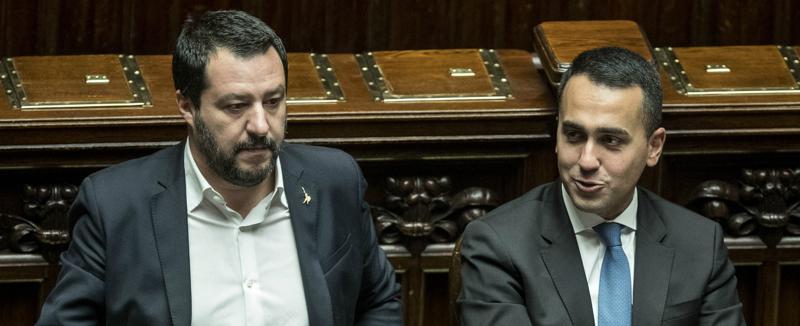
18-12-2018 Rome (Italy). Chamber of Deputies – Law decree on Anticorruption
In the photo Matteo Salvini, Luigi Di Maio (Photo Roberto Monaldo / LaPresse)
Today
Today it seems that the old national states, born in Europe two centuries ago, have not yet realized that they are old. New state forms are springing up, multi-ethnic cities like Singapore, or political geo-economic projects like the U.S., or party-state China.
Actually, the European Union now holds together the old national states of Europe. Without the EU many of these states (Spain, torn with Catalonia, Italy broken between north and south, or even Germany still split between east and west) could fall apart. The United Kingdom is a glaring example. Here the centrifugal pulls of Scotland, Wales, and Northern Ireland against England increase in proportion with the English insistence to Brexit.
In all of this, the Italian situation seems to be at a very important cultural and spiritual nexus: the country has lost the sense of tragedy to deceive itself every day with comedies. Of course, always living in tragedy creates a state of often artificial anxiety that makes people lose the sense of reality, so the comedian brings us back down to earth.
But the tragedy (see Hal Brands and Charles Edel’s The Lessons of Tragedy: Statecraft and World Order, 2019) shows the danger, and alerting the people of the next drama, also gives an indication of how to get out of it.
After World War II, Italy produced tragedies with neorealism. There was a sense of alarm about the past danger and what was before it. Then came the Italian comedies that brought a sense of balance.
But in the last 30-40 years, tragedy seems to have disappeared from Italy, buried by an avalanche of farce, skits, and comedies. Or it has become serious and subtle, or even has changed into a kind of neo-apology of perennial and unbeatable evil, like with the beautiful TV series Suburra and Gomorrah, where the state is a horizon of tissue paper and the main characters are extreme delinquents.
Overall, two sets of problems arise for the four protagonists of Italian politics of the moment.
The first is that the idea of what is “left” or “right” has been lost.
On the left, for example, there is the collapse of the well-being of the middle class and the expansion of a society of legal immigrants (perhaps even three million) who pay taxes but do not vote. Therefore, the Italian democratic base is broken (taxation without representation), but this immigrant population “is in competition” with the former impoverished middle class. On the other hand, in this impoverished middle class, there are many pensioners who no longer contribute to the growth of the country but still vote.
There are immense social problems that need articulated answers.
The same is true on the right. For example, there is the deterioration of the basic order of cities large and small, and of cleaning public life. There is a sense of personal security in crisis, and the threat to private savings from an economy that has practically stopped growing for 15 years. Moreover, there is the change in Italian social fabric due to the arrival of millions of immigrants with different cultures and sensibilities. These are real issues that cannot be solved by sloganeering but with a concrete, practical project.
A train from east to west made the United States some 150 years ago. The Chinese idea of a train across the Eurasian continent is stirring all kinds of concerns and hopes in the world. Perhaps, similarly a train practically from the North to the South Pole could help to build a new euro-Atlantic purpose.

